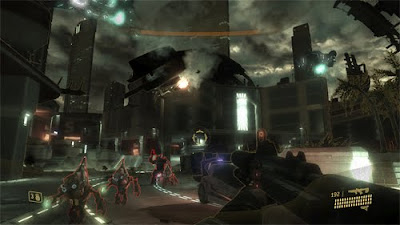For as long as I call myself a gamer, the Far Cry franchise will hold a special place in my heart. I cannot call myself a diehard fan, as I have played only Far Cry Instincts and Predator (both, conveniently, on one disc). However, I logged more hours on those games than many others in my library, largely because of the addicting map editor, but also because the story was attractive enough to make me develop a fondness for the main character and the exotic places to which the game carried me ).
So I was immediately intrigued when I saw a magazine article about Far Cry 2 and read the entire article, as well as any I could find online, topping off my casual mania with the first pre-order in my time as a gamer. When release day came, I happily collected my copy and eagerly loaded the game into the console. Far Cry 2 is set in wilds of Africa, a somewhat exotic locale for a mainstream videogame, and one which did not disappoint . In the intro scene — a first-person, mood-setting ride through the savannah — the player takes in the flowing, amber hills and sage-green brush, as well as some ominous signs about what is in store for the player . As you are chauffeured towards a small town, you are subjected to a one-sided conversation with a guide, who laments the violence between two warring factions and the difficulty of civilians leaving the war-torn, unnamed nation. As the guide rambles on, evidence of the conflict appears along the road: burning shacks, wildfires and, in one particularly tense moment, a faction-controlled checkpoint that the guide bribes in exchange for safe passage.

Far Cry 2 is a free-roaming game, much like previous sandbox-style games such as the Grand Theft Auto Series. Players have substantial flexibility in how they approach missions and are free to select the weapons, routes and even time of day they wish to attack. One thing that is different from other similar games is that instead of provoking responses from enemy forces that start at ”timid resistance” and eventually reach ”ridiculous armada of tanks, helicopters, etc,,“ Far Cry places faction camps at crossroads and other important areas that you must scheme around. You can either attempt to sneak past, strike guerilla-style and thin their numbers or attack them head on. The stealth option can be difficult, as the AI occasionally seems too difficult to fool, but this just means that you must always be prepared to blast your way out if need be. You can also scream through in a high-speed buggy and watch them scramble to chase you in their assault trucks while you set up on a hill with a sniper rifle or rocket launcher.
Things get really interesting when you decide to start a brushfire, which you can do via a surprising number of options — a flare gun, flamethrower or the back-blast of a rocket-launcher — and watch the enemy get caught in the raging wave. Unfortunately, this game element is not as destructive as you might think, and sometimes you will simply find yourself in an old-fashioned firefight while your brushfire withers among the buildings or decides, as brushfires are want to do, to parade off into the savannah as opposed to barbequing your prey.

The health system is unique and is one of my favorites so far. You have a health bar which is cut into a number of segments. Health within these segments regenerates, but it can only fill up to the next segment. Players carry around a number of morphine syringes, which can be used to replenish all of the segments at once (apparently without risk of overdose, which is good, because you’re going to poke yourself with them so many times in the course of an hour that you could start naming constellations on your forearm).
However, if you get within the danger zone of the last two bars, you start to bleed out, and must subject yourself to improvisational medical care. Sometimes you pull a bullet out with your teeth. Other times you put gauze on a burn. Still others you will actually snap bones back into place and continue on your merry way. It’s closer to realistic than magically auto-healing Call of Duty style, but it does place the player in the list of super-manly men from Mars every time he casually yanks rebar out of his midriff.
No, that is not hyperbole. That is an actual healing sequence.
Ironically, this health system does not prove to be clunky, despite its seemingly complex nature. Even within multiplayer, which has an only slightly different version , it leads to tense, even epic situations in which you gun down two people with an auto-shotgun, heal your wounds in a hut and then maul someone trying to capitalize on your wounds with a sub-machinegun. You will get gunned down just seconds before you are healed more than once, but it rarely becomes grating.
On that note, multiplayer is done fairly well, with weapons that demonstrate the developers made earnest attempts at balancing the experience, but did not succeed to the degree we are used to in this generation. This is probably because of the nature of the weapons, which come in three tiers per class, minus the special weapons, with the last tier being absurdly powerful.
One problem in particular is that a few basic weapons seem to reign supreme, while others have no value beyond style points. On most maps, decent snipers, especially one wielding the .50 caliber that can be quickly unlocked, can make being in the open extremely risky. This is a problem, seeing as many of the maps have large, open, hilly areas, characteristic of the savannah. This problem is compounded by the fact that the .50 caliber is a one-hit down and astoundingly accurate when fired from the hip, meaning that even an auto-shotgun ambush can fail with a single, well-placed shot.

The flamethrower, though devastating in campaign, is a very risky weapon of choice on all but a few maps. The enemy only takes damage from being set alight, and any follow-up blasting is a waste of time, except maybe to blind the enemy while you scramble for cover, hoping that they roast before they find you. This was especially disappointing to me, though I understand it to a degree, because I have a veritable fetish for flamethrowers. Finally, the basic class, which begins with an assault rifle, is somewhat overpowered in most scenarios, and outlandishly so once the grenade launcher sidearm is unlocked. The grenade launchers in general, as there is also a four-round, high speed, sniper-accurate grenade launcher to be unlocked, make Far Cry 2 multiplayer a bit more of a painful, nerve-wracking and abrupt experience than it should be, at least for anyone like me who refused, perhaps foolishly, to jump on that particular bandwagon.
Overall, it is exceedingly well done, with successful new ideas, excellent story elements and only a few clunky features. But some part of our gamer nature plays with the new toys, tires of them (at least for awhile) and dreams of what the next next-generation game can do to make it better.
Rating: A
Platforms: Xbox 360, PC, PlayStation 3
Price: $59.99
ESRB: M for Mature
Pub: Ubisoft
Dev: Ubisoft Montreal
Players: 1
.png)

















